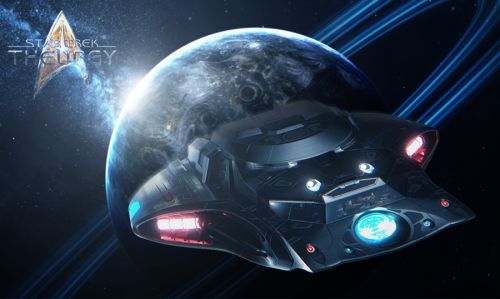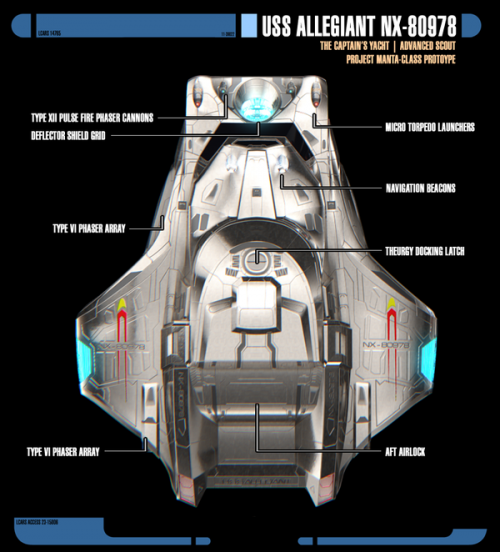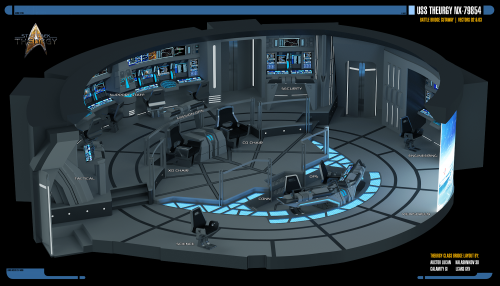USS Allegiant NX-80978
From Star Trek: Theurgy Wiki
Vessel Name: USS Allegiant (commonly ref. as "the Yacht") Registry: NX-80978 Class: Project Manta Prototype Role: Advanced Multi-Purpose Scout (Exploration, SAR, Tactical) Constructed: Antares Fleet Yards & Utopia Planitia Fleet Yards Commissioned: December 21st, 2379 Dedication: "Let my armies be the rocks and the trees and the birds in the sky." Dimensions: 20 x 25 x 6 meters Full Impulse: 0.856c Standard Cruising Speed: Warp 5.2 Maximum Cruising Speed: Warp 7.5 Emergency Speed: Warp 8.56 [for an 2h duration] Defense Abilities: 390 Isoton/s Shields (comparable to Valkyrie Mk. III specs) 11.1cm Type II Ablative Hull Armor (11.5cm OCP) (comparable to Valkyrie Mk. III specs) FSQ-2 Deflector Shield Tractor beam system Class 5 Sensor Array (x 2) LF-9X4 Compact Warp Drives FIE Impulse Engine Standard RCS Thruster Assembly Standard Navigational Sensor Suite Transporter Systems (2 pads, capable of beaming up to 6 people at once) Mission configurable cockpit (1,2, or 4 person setup) Spartan crew quarters for 10 (can easily be rearranged adding cots for passengers) Small crew lounge with basic replicator and head (lounge can be converted to room for additional passengers.) Advanced life support capabilities (even if the entire ship was packed with people at a standing room only capacity, atmospheric systems will last longer than maximum approved mission duration of 2 months*) Tactical Abilities: x 4 Type VI Phaser Arrays x 2 Type XII Pulse Fire Phaser Cannons x 3 Mk 25 Direct-Fire Micro Torpedo Launchers (55-round 12cm Type IV Micro-torpedoes each) 2 forward 1 aft Armory (locker-sized)
Crew Compliment
Standard crew: 5 (Commanding officer, Pilot, Operations officer, Tactical officer & Medical officer Spartan crew: 2 (Commanding officer & Pilot) Minimum crew: (1) Pilot Maximum crew: 10 (Commanding officer, CONN officer, Operations officer, Tactical officer, Communications officer, Engineering officer, Mission specialist, Medical officer & Security officers (2) Passenger compliment: Standard operations allow up to 20 Maximum occupancy: Untested
The Yacht, like many of the other things stationed on the USS Theurgy, is an experimental prototype. When it was decided that the Theurgy would serve as an experimental testbed for both a fighter squadron of the new mark 3 Valkyries and for a new system of computer interface (the Ship A.I.) it was decided that for a Captains Yacht they would integrate the prototype for the newest in the aeroshuttle series of scouting vessels into the hull of the saucer vector. It was an augmented version of the Talon-class scout, only refereed to as Project Manta by the Advanced Starship Design Bureau.
Project Manta was the culmination in a long line of mission-specialized auxiliary craft starting with earlier development of the Peregrine-class Federation Attack Fighter. The successful deployment of this ship for patrols near the Cardassian DMZ led to the development of a hybrid Runabout-fighter geared towards atmospheric flight and combat but also equipped with specialized sensor packages allowing for detailed planetary scans. This project led to the aeroshuttle-design, though it never gained much widespread use. Its advanced sensor package and atmospheric capabilities were further fine-tuned into the development of the Talon-class scout ship, which had gained much more widespread use within the Federation as a deep-space reconnaissance craft and as a medium sized military transport. Given the Talon's advanced sensors and its capabilities to be further amplified, small sleets of these crafts could be deployed along the Federation's various neutral zones to aide in the detection of cloaked ships.
Another notable accomplishment of the Talon-class was how its size and flight-profile was used in the development for the first wave of experimental fighters in the Valkyrie-project. With the commissioning of a Mk III iteration of the Valkyrie Attack Fighter, the Talon-class scout ship was becoming outclassed and it was becoming apparent that in an arms-race where a single fighter could potentially destroy the scout, improvements were required to be made in order to keep the aeroshuttle-series a viable tactical choice.
It was with this in mind that development began on the first prototype of the new Exploration Scout. The exploration scout would be viable for much longer mission lengths and would house a larger crew while still retaining the "aerowing" design that had made the series excel in atmospheric situations. It was decided that in lieu of a standard Talon-class scout being embedded into the Theurgy's hull as a Captains Yacht, the Theurgy would have its hull modified to have the Manta instead. Just like it's registry, it was also given an official name besides 'the Yacht', and that was the Allegiant.
Interior Layout
The cargo bays can be easily converted into passenger quarters by moving bunk cots as beds. Each warp nacelle is powered by a separate warp core, both of which feed into the opposite side's "nacelle" as well. In the event that one core is ejected, the ship should, theoretically, be able to fly at low warp velocities.
The cockpit is holds one central seat with two control stations behind it, creating a copilot and tactical desk as well as a Captain's chair against the back wall. During missions, the Co-pilot may act in both a Communications and Ops capacity, in some cases in a Mission-Ops type role as well. Basically, if its a duty other than sensors, flying, firing weapons, or operating shields, then it is probably going to be handled via the Co-pilot's station. As a general rule - like the helm of a starship - the pilot's job is to fly. If there is no one at Tactical, then the pilot flies, controls weapons, and controls shields, similar to the role of a Tactical CONN officer when piloting a fighter.
Adjacent to the cockpit is the Sensor and Sciences room. Sensor room has a small porthole to the front. Captain's observation room has a large transparent aluminium window similar to observation lounge windows. If the captain is not aboard the yacht, the Captain's Quarters and similar rooms are locked and are not to be entered. If the captain wishes for the ranking officer of the ship to be given the use of the Captain's luxuries, then it is the Captain's right to grant that single officer access for duration of the mission.
Main Bridge in Vector 01:
Battle Bridges in Vector 02 and 03:
Note: Mission Ops is reserved for the First Officer/XO
MVAM Procedure Transcript: For when MVAM is executed via computer and not by use of the auxiliary Battle Bridges.
Captain/Commanding Officer: Engage the multi-vector assault mode.
Computer: Initiating decoupling sequence. Auto-separation in ten seconds. Nine. Eight. Seven. Six. Five. Four. Three. Two. One. Separation sequence in progress.
Tactical Officer: We are in attack formation. Each section is armed and responding to our command.
Captain/Commanding Officer: Attack pattern ["Beta four seven" or the like].
Computer: Specify target.
Captain/Commanding Officer: [State vessel], bearing ["one six two mark seven" or the like].
Computer: Pattern and target confirmed.
[Post battle]
Captain/Commanding Officer: Begin the reintegration sequence then get me a full damage report.
Computer: Reintegration sequence complete.
Attack Patterns: For when MVAM is executed via computer and not by use of the auxiliary Battle Bridges. Each vector can be controlled from the Main Bridge by continuously assigning them attack and defensive patterns. This is done from the Tactical station, with the influx of commands from the commanding officer on the Bridge.
Offensive / Attack Manoeuvres
Alpha Starfleet's most basic offensive manoeuvre, attack pattern Alpha involves a mostly straight-on approach to the target, with some slight vectoring to the side based on the ship's weapons complement and the target's movement.
Beta-series Manoeuvres Beta-1 The ship dives down between two enemy ships, firing at least once at each of them (and hoping they themselves will miss and hit each other if properly aligned. Beta-2 Approaching the target closely, within 90,000 kilometres, the ship jinks to starboard of the target, then dives beneath it to emerge on its port ventral side, firing as it goes. Beta-3 The ship makes a broad arc turn around one or more ships, attacking them as it goes. Beta-4 The ship climbs steeply, veering to port or starboard, then quickly dives back down, firing at one or more targets as it goes.
Delta-series Manoeuvres
Delta-1
The ship swoops up from underneath a target to attack its vulnerable ventral side.
Delta-2
The ship swoops over the target from starboard to port, then back from port to starboard (diving underneath the target on the second pass of necessary), firing as it goes.
Delta-3
The ship dives straight down at, or climbs straight up at, the target, firing forward weapons.
Delta-4
An all-out, straightforward frontal attack.
Delta-5
A long, relatively shallow dive to one side of the target (usually whichever way allows the ship to bring the most weapons to bear or which uses the target to take cover from other ships' attacks.
Kappa-series Manoeuvres Kappa 0-1-0 From a superior position, the ship arcs down and and around its target to port, firing as it goes. Kappa 0-2-0 The ship flies on a carefully-calculated arc through a battlefield, firing at multiple targets.
Omega-series Manoeuvres Omega-1 As the ship approaches the target head-on, it jinks to one side and dives steeply from one end of it to another. Omega-2 The ship rolls from one side to the other giving its weapons maximum exposure so the Tactical Officer can engage multiple targets. Omega-3 The ship veers back and forth across the battlefield like a darting swallow, attacking vulnerable targets.
Sierra-series Manoeuvres Sierra-1 The ship swoops in from an aft dorsal angle to attack the target from behind. Sierra-2 While seeming as if it will pass a particular target, the ship turns to face it head-on and attacks. Sierra-3 The ship flies through the heart of a battle, jinking back and forth to avoid enemy attacks as it attacks choice targets. Sierra-4 The ship comes up from beneath the target(s) and loops up over it/them.
Defensive / Evasive Maneuvers
Alpha-series Manoeuvres Alpha-1 The ship jinks to one side and dives. Alpha-2 The ship climbs steeply out of harm's way.
Beta-series Manoeuvres Beta-1 The ship climbs slightly, then dives down. Beta 1-4-0 A quick complex manoeuvre involving several rapid turns. Beta-2 The ship climbs slightly, then jinks hard to port or starboard. Beta-3 The ship climbs slightly, then jinks slightly to port or starboard and lunges forward. Beta-4 The ship climbs steeply, then jinks to port or starboard and climbs slightly. Beta 9-3 A short, rapid dive followed by a quick series of jinks and turns designed to throw off the aim of any opponent.
Delta-series Manoeuvres Delta-1 As it flies along a relatively straight vector, the ship jinks slightly from one side to the other. Delta-2 The ship does a barrel roll to go from being in front of its pursuer to above and behind it. Delta-3 The ship jinks hard to port or starboard and then drops back. Delta-4 The ship jinks hard to port or starboard and then slides downward in a shallow dive. Delta-5 The ship jinks hard to port or starboard and then climbs in a shallow, climbs in a shallow, curving arc.
Gamma-series Manoeuvres Gamma-1 The ship veers to port or starboard in a broad arc, then suddenly jinks in the opposite direction. Gamma-2 The ship jinks downward in a slight dive to port or starboard, then climbs steeply. Gamma-3 The ship jinks upward in a slight climb to port or starboard, then dives steeply. Gamma-4 The ship turns up its side, then falls away in a steep drop to port or starboard. Gamma-5 The ship dives steeply, turning on its side towards the bottom of the dive and then climbing steeply and levelling out at the end of the climb.
Lambda-series Manoeuvres Lambda-1 A full starboard roll. Lambda-2 The ship makes a half-roll and then drops down.
Omega-series Manoeuvres Omega-1 The ship engages in a complex, stomach-turning series of rapid turns which makes it difficult to track of follow. Omega-2 The ship jinks to the right, upward, and to the right again. Omega-3 The ship dives or climbs to port or starboard, executing a long S-turn as it does so. Omega-4 The ship climbs in an arc, but before reaching the expected top of the arc, it darts quickly forward. Omega-5 The ship peels off to port or starboard, then executes a turn designed to bring him underneath an enemy ship (perhaps one that was pursuing). Omega-6 The ship arcs upward to port, then peels down swiftly to the side from the apex of the turn.
Theta-series Manoeuvres Theta-1 The ship jinks to the side and dives slightly, back to the other side and dives steeply, then climbs about one ship length. Theta-2 The ship arcs to port around its opponent, then peels downward and to starboard. Theta-3 The ship peels off to the side, climbing as it does so, then dives straight down. Theta-4 The ship jinks to starboard, then jinks to port and dives slightly, then jinks back to starboard in a steep dive.
Other Manoeuvres
Cochrane Deceleration
This manoeuvre is efficient when the ship is being pursued by an enemy within 300,000 kilometres. It decelerates suddenly, allowing the enemy to pass it so that it can fire forward weapons.
Picard Manoeuvre
Developed by Captain Jean-Luc Picard in 2355 when he commanded U.S.S. Stargazer, the Picard manoeuvre is only effective against a single target using only lateral sensors, since it relies on a starship's ability to move at faster than light velocities without the target realizing where it's gone. The ship must start out sufficiently far enough from its target that it takes more than five seconds for light to reach the target (more than 1,500,000 kilometres). The ship makes a microwarp burst, thus moving from its current position to one much closer to the target before the target realizes it has moved. The ship drops out of warp, appearing in two places at the same time and fires on the target, hopefully inflicting grievous damage before it realizes what has happened.
Riker Manoeuvre
Developed by Commander William Riker in battle against the Son'a in 2375, the Riker manoeuvre -due to practical considerations- can only be performed in regions of space filled with dangerous, combustible substances such as metreon gas. The ship passes through the gas, collecting it with its Bussard ramscoops. It then flushes the ramscoops, projecting the gas backwards at its pursuers, or forward toward an approaching enemy ship. The enemy's attacks, or a quick phaser blast from the ship ignites the gas, causing an explosion which damages the enemy ship.
Talluvian Manoeuvre
This manoeuvre is a flexible one designed to manoeuvre a ship so that its most powerful phasers are brought to bear on the target for as long as possible. It works best with ships which have streaming phasers rather than pulse phasers. The ship flies above or below its target (depending on which phaserbank is available to use) in a diagonal pattern which allows it to fire its phaser and keeping it locked continuously for as long as possible.
Phonetic Alphabet
The phonetic alphabet is a standardized series of unique sounding words used to spell out letters in order to avoid the confusion of similar sounding letters. Note that some of the letters or numbers have exaggerated pronunciation in order to differentiate them from other words, the numbers five (pronounced "fife" to avoid confusion with the word "fire") and "niner" (to avoid confusion with the German word for "no").
Alpha (AL fah) Mike (MIKE) Yankee (YANG key) Bravo (BRAH VOH) November (no VEM ber) Zulu (ZOO loo) Charlie (CHAR lee) Oscar (OSS cah) 0 (ZEE ro) Delta (DELL tah) Papa (pah PAH) 1 (WUN) Echo (ECK oh) Quebec (keh BECK) 2 (TOO) Foxtrot (FOKS trot) Romeo (ROW me oh) 3 (TREE) Golf (GOLF) Sierra (see AIR rah) 4 (FOW er) Hotel (hoh TELL) Tango (TANG go) 5 (FIFE) India (IN dee ah) Uniform (YOU nee form) 6 (SIX) Juliet (JEW lee ET) Victor (VIK tah) 7 (SEV en) Kilo (KEY loh) Whiskey (WHIS key) 8 (AIT) Lima (LEE mah) X Ray (ECKS RAY) 9 (NINE r)




